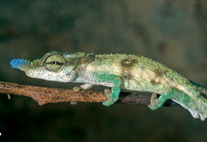Abstract
We revise the taxonomic status of two species of Madagascan chameleons in light of a recent molecular phylogenetic study on the Calumma nasutum group. The investigation of morphological and osteological characters led to a clear delineation between two species within the C. boettgeri complex, C. boettgeri and C. linotum. Calumma linotum has been considered either a synonym of C. boettgeri or a dubious, poorly defined taxon. So far it has only been known from the male holotype with the imprecise locality ‘Madagascar’. Based on pholidosis, morphological measurements and characters of the skull that were analyzed using micro-X-ray computed tomography (micro-CT) scans, we ascribe the population of chameleons from Montagne d’Ambre, formerly assigned to C. boettgeri, to C. linotum. Calumma linotum differs from C. boettgeri in the larger size of tubercle scales on the extremities and rostral appendage, the larger diameter of the extremities relative to the body size, the presence of a parietal crest as well as the form of the nasal bones and the anterior tip of the frontal. The life colouration of the males is also characteristic, with a blue rostral appendage and greenish turquoise extremities. The body and rostral appendage of C. boettgeri in contrast are inconspicuously yellowish brown coloured. All confirmed distribution records of C. boettgeri are confined to the biogeographic Sambirano region whereas C. linotum is only known from Montagne d’Ambre and a locality at the base of the Tsaratanana massif. Additional literature records of C. boettgeri and C. linotum from northeastern Madagascar are in need of confirmation. We also confirm the synonymy of Chamaeleo macrorhinus (described from a female holotype with an unknown locality) with Calumma boettgeri. The use of micro-CT exposed further characteristics for species delimitation in an integrative taxonomic approach. In addition to the skull, we also micro-CT scanned the hemipenes of C. boettgeri and C. linotum, using an iodine-based tissue stain, and provide 3D PDF models of these organs. This method enables detailed illustration and the detection of variation in particular characters, and might be an important tool in further taxonomic studies on the C. nasutum group and other squamate reptiles.

